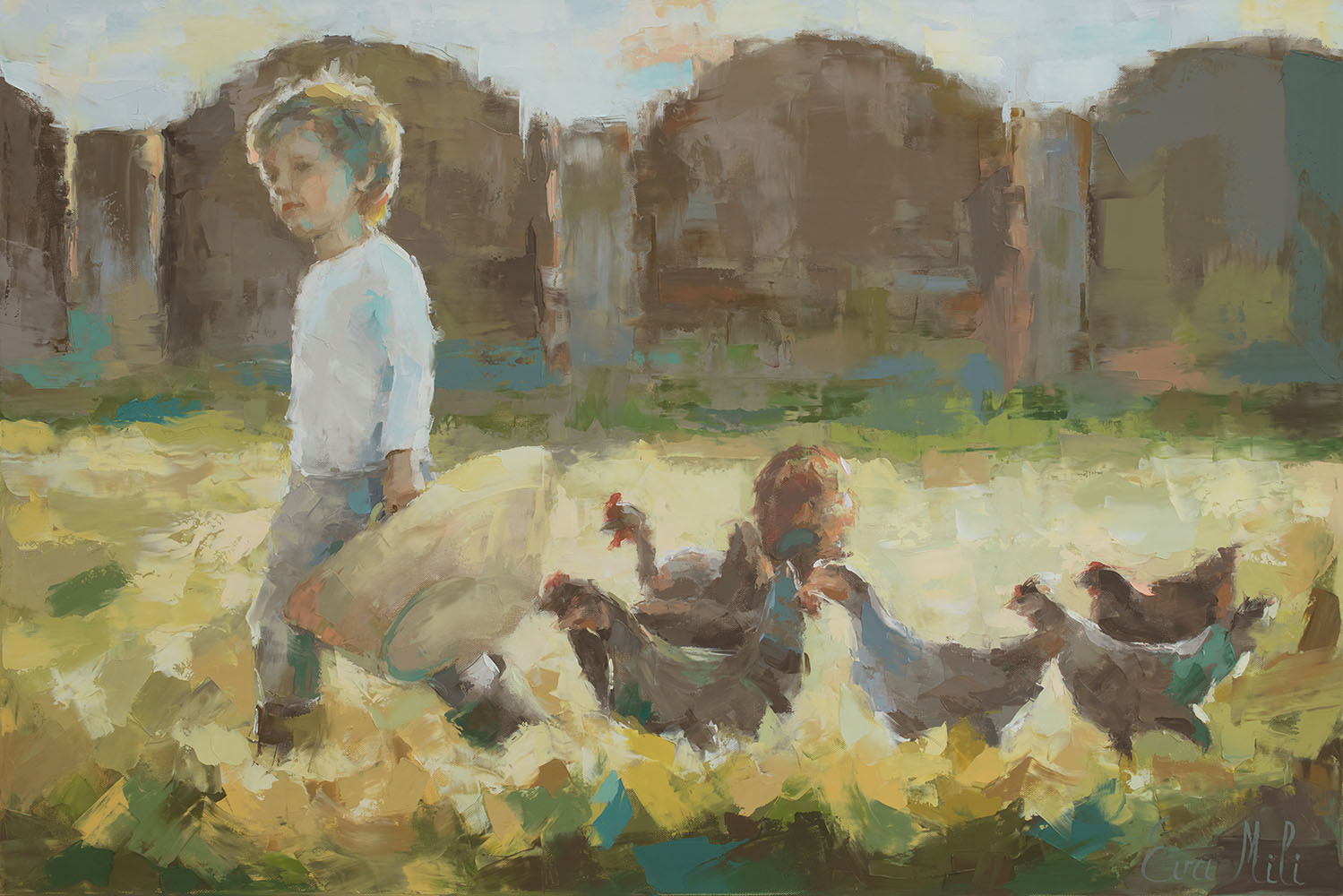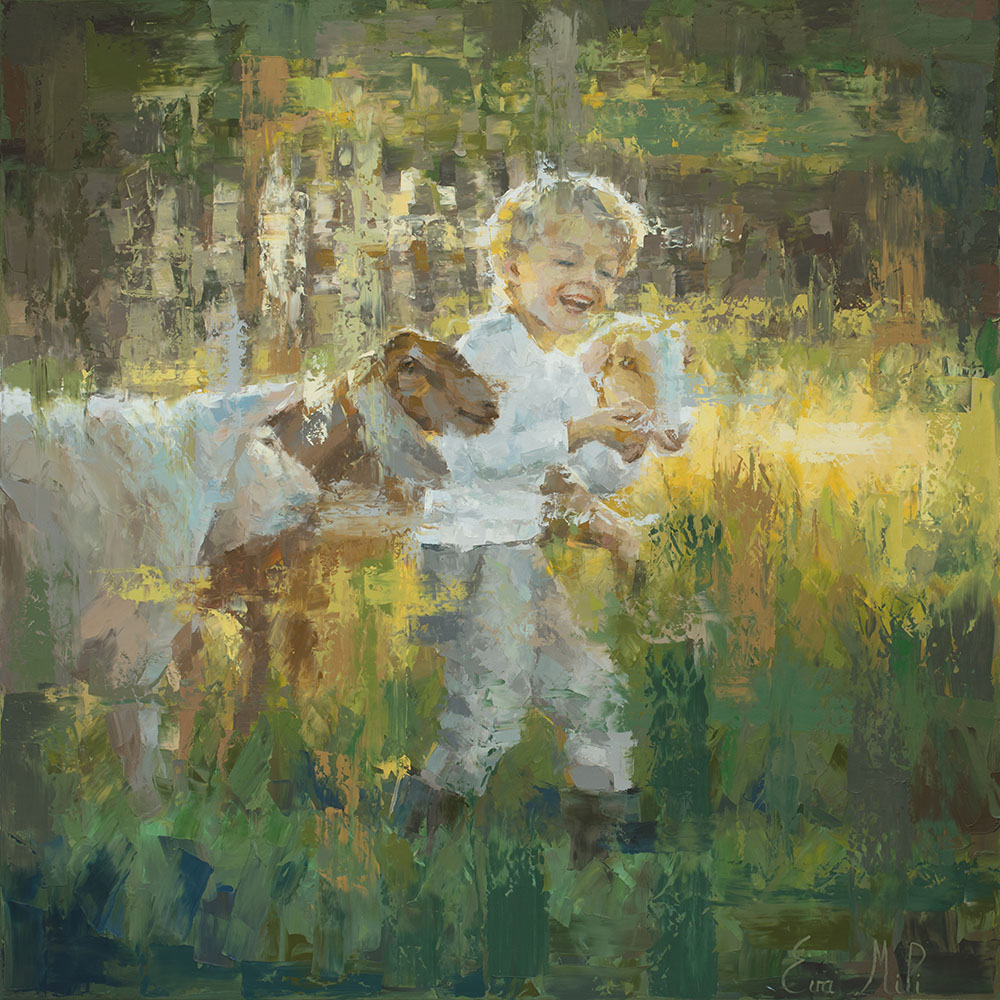Romantic Lightness in the Rational Paintings of Eva Mili
 Kristina Liepinaitė
Kristina Liepinaitė
On a farm near Kazlų Rūda lives a small four-year-old boy named Ąžuolas. He gets along perfectly with the dozens of animals kept on the farm and has many responsibilities—herding chickens, collecting eggs, feeding goats and sheep, and taking care of a pony.
The story of this young boy’s life on the farm has become the subject of Eva Mili’s (the creative name of Eva Miliūnienė) paintings. The artist created 21 paintings on this theme over four years. During this time, the boy grew up, and his childhood was captured not only in photographs but also painted on canvases. The warm, gentle layer of paint preserve the memory of childhood, yet the artist’s choice to immortalize the story through painting is equally fascinating.
Painting as an art form has been a subject of debate for over a century. At the beginning of the 19th century, with the advent of photography—a technology for preserving images—there were talks of the end of painting. However, the Impressionists, Pointillists, and other representatives of late 19th-century modern art proved that photography and painting could coexist. 20th-century painters solidified this art form with thick layers of paint. Expressionist, multi-layered, and even textured painting became the foundation of the Lithuanian national painting school. In the 21st century, we again observe a variety of painting techniques, from single-layer to multi-layered collage.
Eva Mili emphasizes that she paints with oil on canvas, using the single-layer (wet on wet) technique. The first paintings in the series were done with brushes, later replaced by painting knives. Why is it so important to highlight the painting technique? Because Eva Mili is self-taught. She independently searched for the technique that suited her best. She does not represent any Lithuanian painting school and does not have a direct teacher.
Eva Mili mastered the single-layer painting technique, which requires precision, speed, and improvisation simultaneously. Typically, painters favor glazing or thick layers of paint, allowing more time to create and refine a painting. A new layer of oil paint is applied only after the previous layer has completely dried, which can take from a few days to several weeks, depending on the thickness of the paint. Eva Mili’s chosen technique involves creating paintings while the paint is still wet, similar to watercolor, where a stroke is irreplaceable. However, Eva Mili creates her paintings with oil paints. This technique is complex and rarely used by painters, although it was used to create painting masterpieces as early as the 16th century.
What masterpieces does Eva Mili create, and what kind of artist is she? Currently, her exhibition “The Farm of Ąžuolas” is on display at the Birštonas Kurhaus Gallery (April 27 – May 27, 2024). As stated in the exhibition’s annotation: “From afar, my paintings look quite realistic, as if creating a living image. However, upon closer inspection, a different perspective opens up, everything becomes an illusion, only rough strokes emerge.” This is the paradoxical charm of Eva Mili’s paintings. Bright, sunny scenes captivate. They draw you in and make you want to get closer. Your hand reaches out to stroke the boy’s head as your eyes begin to analyze the brushstrokes. Reality gains new sensory layers, determined not only by the painting technique but also by the artist’s skills.
Eva Mili’s path to painting went through information and computer technologies and other art forms. Eva was a programmer. In 2007, she took up professional photography. Ten years later, she decided to replace the art of light with the creations of brush and paint. Eva Mili’s photography skills, precise sciences, and technological thinking helped develop a new, unique style of painting. The light tones of her paintings are like reflections of light patterns, and simultaneously, a unique view of Eva Mili’s world. Precision, order, and… gentleness, lightness at the same time. From her very first paintings, Eva Mili revealed herself as an artist with exceptional talent, capturing sensations, moods, and emotions in her work.
Starting painting in 2017, Eva Mili has already held five memorable exhibitions: “Portraits,” “Childish Stories,” “A Dog’s Life. Cat Days,” “Ballet Class,” and “The Farmof Ąžuolas.” Even in her earlier exhibitions, Eva Mili proved herself a superb portrait artist, capable of not only accurately depicting figures but also capturing moods and emotional states. In this exhibition, where Eva Mili focuses on the life motifs of a single boy, Ąžuolas, the artist reveals herself as a great storyteller—her works are eloquent, engaging, and create a romantically bright mood.
Kristina Liepinaitė. Romantic Lightness in the Rational Paintings of Eva Mili. NAUJASIS GĖLUPIS. May 18, 2024.
Kristina Liepinaitė. Romantic Lightness in the Rational Paintings of Eva Mili. www.alkas.lt May 20, 2024.
 “The Farm of Ąžuolas. Little Goatherd”
“The Farm of Ąžuolas. Little Goatherd”70x70cm (27.6″ x 27.6″)
 “The Farm of Ąžuolas. Rooster Singer”
“The Farm of Ąžuolas. Rooster Singer”50x50cm (19.7″ x 19.7″)
 “The Farm of Ąžuolas. Apple for the Goat”
“The Farm of Ąžuolas. Apple for the Goat”90x90cm (35.4″ x 35.4″)
 “The Farm of Ąžuolas. Happy Geese”
“The Farm of Ąžuolas. Happy Geese”50x50cm (19.7″ x 19.7″)
 “The Farm of Ąžuolas. Two White Goats”
“The Farm of Ąžuolas. Two White Goats”80x70cm (31.5″ x 27.6″)
 “The Farm of Ąžuolas. Two Speckled Hens”
“The Farm of Ąžuolas. Two Speckled Hens”70x60cm (27.6″ x 23.6″)
 “The Farm of Ąžuolas. Chicken Herder”
“The Farm of Ąžuolas. Chicken Herder”90x60cm (35.4″ x 23.6″)
 “The Farm of Ąžuolas. Happy Rider”
“The Farm of Ąžuolas. Happy Rider”90x90cm (35.4″ x 35.4″)
 “The Farm of Ąžuolas. Joyful Companions”
“The Farm of Ąžuolas. Joyful Companions”90x90cm (35.4″ x 35.4″)
 “The Farm of Ąžuolas. Run, Little Chicks”
“The Farm of Ąžuolas. Run, Little Chicks”100x80cm (39.4″ x 31.5″)
 AT THE EXHIBITION: Eva Mili with the main hero of the paintings, Ąžuolas
AT THE EXHIBITION: Eva Mili with the main hero of the paintings, Ąžuolas